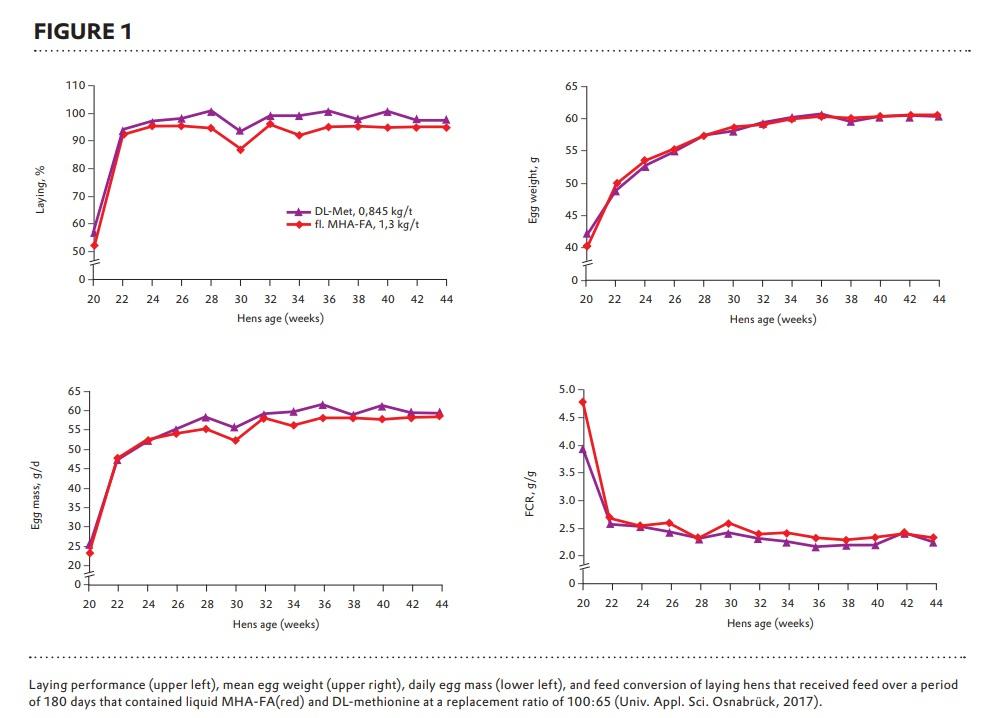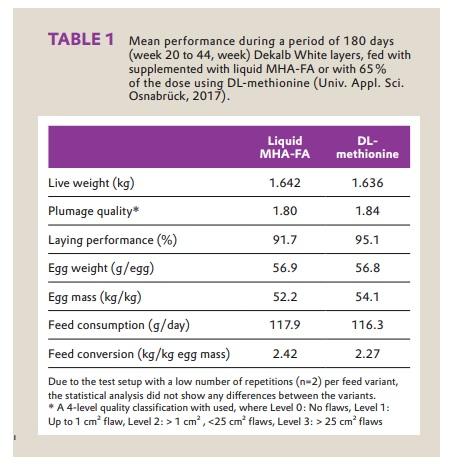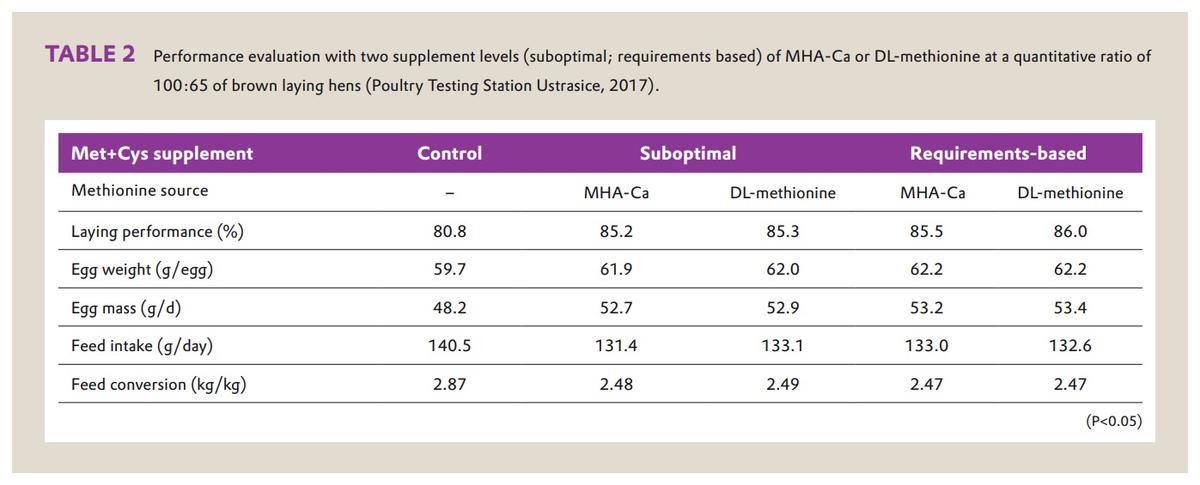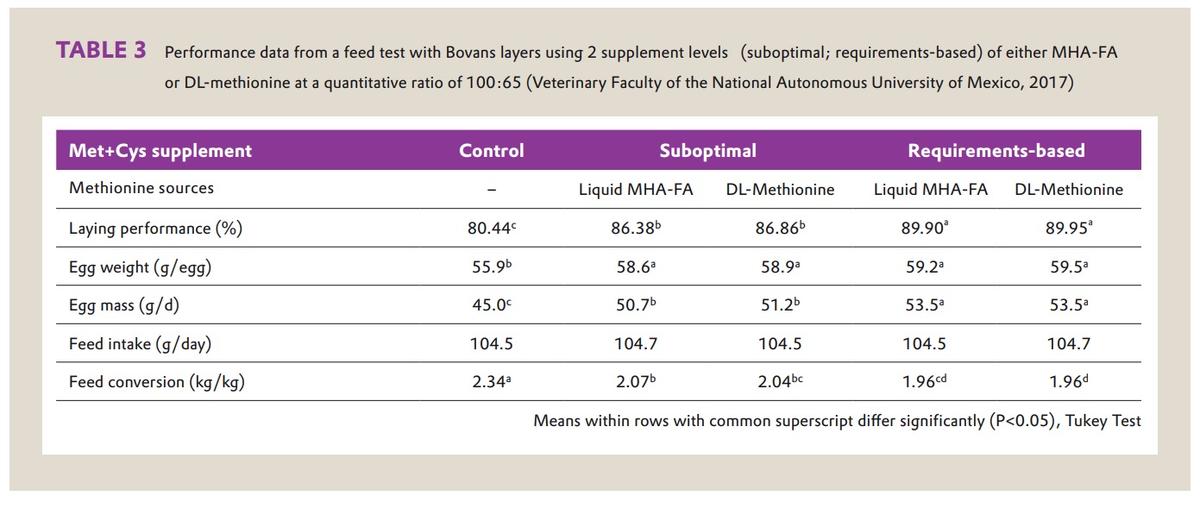
Content sponsored by:
Evonik Animal Nutrition
DL-methionine can replace methionine-hydroxy anlalog products in a ratio of 65:100 in laying hen fee
Published: August 15, 2018
By: Carlos de la Cruz, DVM, MSc. Global Expert Egg Production. Evonik Nutrition & Care GmbH.
Three recent feeding studies confirm that supplying laying hens with adequate dosages of a methionine is necessary to optimize performance, but moreover, products of the methionine-hydroxy analog (liquid MHA-FA; MHA-Ca) are interchangeable with DL-methionine at a ratio of 100:65, without having any negative effect on egg production performance. Assessment of the relative bioavailability of MHA products should be reflected both in the respective dosages and in the purchase price of the products, in order to optimize feed costs.
For many years a discussion on chemical and biological characteristics of DL-methionine (DL-Met) and the hydroxy analogue products of DL-methionine (liquid methionine-hydroxy analog, MHA-FA; methionine-hydroxy analog calcium salt, MHA-Ca) has continued in the feed industry, including bioefficacies of the compounds in different productive animal species. Therefore a number of studies have been carried out to demonstrate that MHA products in feed can be replaced through DL-Met at an exchange rate of 65 % compared to the MHA dose without any negative effect on performance.

In this context, a Bachelor thesis was written at the University of Applied Science in Osnabrück, Germany. Furthermore, a feed test was conducted at the International Poultry Testing Station in Ustrasice in the Czech Republic and finally a trial was carried out by the Veterinary Faculty of the National Autonomous University of Mexico in Mexico City. These 3 recent works examined the recommended interchangeability of the methionine sources at a 100:65 ratio in laying hen feed under different production conditions.
126,000 white laying hens of a commercial operation were available for a large scale trial in Germany.
In the area around Osnabrück in Germany, a 180 days (two feeding phases) commercial test was carried out using a total of 126,000 ISA-Dekalb White hens 20 weeks of age. Layers were held in 2 houses with 2 floors and 6 aviaries per floor. Various performance parameters including feed intake, laying percentage and egg weights as well as body weight and plumage quality were recorded. Feeds tested differed only in the methionine source used. Whereas liquid MHA-FA was used in standard feed (1.30 kg/mt), experimental feeds contained 0.845 kg/mt DL-Met which is equivalent to a ratio of 100:65. Phase 1 and phase 2 feeds contained 17 % and 16 % of crude protein, respectively.
The cumulative results (Figure 1, Table 1) draws the conclusion that using DL-Met at a quantitative ratio of 65% has no disadvantageous effects compared to the use of liquid MHA-FA, as reflected particularly in laying performance, egg mass, and feed conversion. Furthermore, it can be seen that the curves for laying performance, daily egg mass, and feed conversion ratio actually show slight improvements starting at the 23rd week.
Long-term study in Czech Republic using brown hens in enriched cages.
A second study also explored the interchangeability of methionine products in 18 weeks old Isa-Brown layers. During trial duration of 32 weeks 1440 hens were tested in enriched cages in groups of 30 at the International Poultry Testing Station Ustrasice, in Czech Republic. A typical European diet based on wheat, maize, soybean meal and wheat bran was the basis for the 5 treatments and represented the control group (n=12) that contained no methionine supplement and had a methionine + cysteine content of 0.53%. Two additional groups (n=9 each) with 1.2 or 2.4 kg/mt MHA-Ca and two further treatments (n=9 each) in which DL-Met was added to the feed at amounts of 0.78 and 1.56 kg/mt corresponding to a replacement ratio of 100:65 for the two inclusion levels completed the trial design. The lower dosage was included to make the test more sensitive.

As expected, negative control group performed worse than the other treatments. Supplemented MHA-Ca and DL-Met in general improved performance, therefore it can be concluded that supplemented methionine was essentially required for Testoptimized performance. However, the differences between the two supplement levels were small and can be seen in numerical differences in daily egg mass (0.5 g/d) and feed conversion (1 – 2 points).


Layers allocated in conventional cages under Mexican production and feeding conditions
A third experiment with similar setup as the previous trial was ran in Mexico. The trial used 420 Bovans layers of 37 weeks of age, held in conventional cages fed with a sorghum and soybean meal based diet. Five treatments with 7 replicates of 12 birds/replicate included a control group with no methionine inclusion, 2 treatments with suboptimal (50 %) level of 1.12 kg/mt liquid MHA-FA and 0.73 kg/mt of DL-Met and 2 additional treatments with an inclusion of 2.25 kg/mt liquid MHA-FA and 1.46 kg/mt of DL-Met. Dosages of methionine sources at both dosages equaled a ratio of 100:65.
Production parameters after 12 weeks displayed in Table 3 showed a significantly lower performance of the control group, as expected. Whereas increasing dosage of methionine sources gradually and significantly increased performance, there were no differences between methionine sources in corresponding treatments. Similarly as observed in Czech Republic, it can be concluded that supplemented methionine was essentially required for optimized performance. Also, this trial confirms the interchangeability of the methionine sources at a quantitative ratio of 100:65.
There remains no doubt about the inter-changeability of the methionine sources at a ratio of 100:65 and - most important – this has significant economic advantages.
Comparing the corresponding groups treated with MHA products and DL-Met, it can be confirmed that the quantitative replacement ratio of 100:65 (MHA products: DL-Met) had no negative effects on laying hen performance. Therefore, at a DL-Met price of 2.50 €/kg, respective MHA product price should be 1.62 €/kg, corresponding to 65 % ratio. In other words, MHA products would not be competitive with prices higher than 1.62 €/kg compared to DL-Met at 2.50 €/kg. So, purchasing MHA products at a price higher than 65 % of the price of DL-Met will reduce profitability.
Related topics:
Authors:

Influencers who recommended :
Victor Naranjo Haro, Dr. Andreas LemmeRecommend
Comment
Share
Adisseo
27 de septiembre de 2018
An interesting study, considering the fact that not a lot has been done on layers in this regard. The findings are not surprising to me, though. Well done Carlos!
Recommend
Reply

Would you like to discuss another topic? Create a new post to engage with experts in the community.



